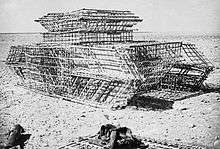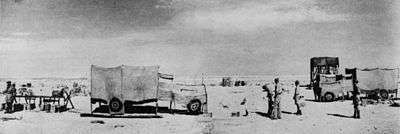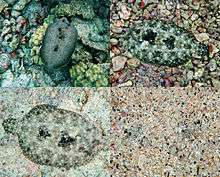Middle East Command Camouflage Directorate

The British Middle East Command Camouflage Directorate (known simply as Camouflage) was led by filmmaker Geoffrey Barkas, with a team of camouflage officers or "camoufleurs". The team included the artist Steven Sykes, the first Camouflage GSO2 in the British army.
Camouflage's major operations for Middle East Command included disguise and deception work during the Siege of Tobruk; a dummy railhead at Misheifa, and the largest of all, Operation Bertram, the army-scale deception for the battle of El Alamein in October 1942.
These operations saved lives and contributed to victory by diverting enemy attention from real targets to dummy ones, wasting enemy ammunition, preserving vital resources such as the single water desalination plant at Tobruk, and deceiving the enemy as to allied strength and intentions. Operation Bertram may also have been the last ever army-scale physical deception, since subsequent major deceptions, including those for the D-Day landings in Normandy, have included electronic measures.[1]
Foundation
Camouflage's leader, Geoffrey Barkas (1896–1979) served in the 1915 Gallipoli campaign and then in the later part of the Battle of the Somme in France, where he won a Military Cross.[2] Between the wars, Barkas was a filmmaker, working as a writer, producer, and director.[3][4] In 1937, Barkas joined Shell-Mex/BP under Jack Beddington, who guided Barkas into military camouflage.[5] In May 1940, he was rapidly drafted into the Royal Engineers with a summary 10-day basic training course,[6] followed by a camouflage course.[7] He developed his thinking in Northern Ireland in 1940, teaching, running demonstrations, and writing an instructional pamphlet.[8]
Organisation
The Camouflage Directorate included a training school and a development wing, both based at Helwan, Egypt, as well as a factory and experimental section.
At the end of 1940, Barkas and his camoufleurs were sent to Egypt, where he arrived on the Andes on New Year's Day 1941. He arranged a flight to observe the desert from the air, noting patterns that he named as "Wadi", "Polka Dot" and so on that he hoped to use for camouflage.[9] To get his fledgling unit recognised, he printed an unusually elegant booklet called "Concealment in the Field" in Cairo, the idea being to produce something clear, readable, and above all obviously different from the mass of army manuals. He was surprised to have this at once recognised as an "operational requirement" by the British Army's Middle East Command, that is, as an essential item for every army unit.[10] Barkas was promoted to "Director of Camouflage" with the rank of Lieutenant-colonel.[2] On 19 September 1941, Steven Sykes became the first Camouflage GSO2 in Eighth Army and indeed in the whole of the British Army, and was promoted to Major.[11] From the start of 1942, Peter Proud was the staff officer (GSO2) responsible for training and development.[12]
The camouflage training school was set up at Helwan in November 1941, with the zoologist Hugh B. Cott as chief instructor; he had the rank of Captain.[5] Peter Proud was responsible for ensuring that the training provided was practical and useful.[12] The development wing was commanded by A. E. Upfold.[12] The factory and experimental section at Helwan produced "a stream of new ideas for dummy vehicles, tanks, aircraft and all the other portents of impending battle". Every new device was carefully tested by observation from the air, through collaboration with the Royal Air Force.[13]
Deception operations
Dummy railhead for Operation Crusader

One of Camouflage's first major deceptions was the dummy railway at Misheifa. Barkas assigned the artist Steven Sykes to build a convincing dummy to divert enemy attention from the real railhead at Capuzzo bringing materiel for Operation Crusader. This complex deception involved 6 miles of dummy railway, a dummy train, dummy sidings, and a selection of dummy tanks, all made of gerida palm hurdles and other simple materials, to look as if they had been delivered by the railway. More than 100 bombs were dropped on the Misheifa railhead, at least halving the attacks on the real thing at Capuzzo, giving the lie to the jokes[15] about wooden bombs being dropped on wooden railways by an undeceived enemy. Barkas noted that "camouflage men must be among the few otherwise sane beings who yearn to be bombed." The pioneering effort's success was achieved in a few weeks, amidst severe shortages of men and raw materials.[16] The writer Julian Trevelyan recorded that
The dummy railhead looks very spectacular in the evening light. No living man is there; but dummy men are grubbing in dummy swill-troughs, and dummy lorries are unloading dummy tanks, while a dummy engine puffs dummy smoke into the eyes of the enemy.— Julian Trevelyan[15]
Camouflage and deception in the siege of Tobruk
During the Eighth Army's retreat across Libya in 1941, Peter Proud and William Murray Dixon found themselves trapped in the port city of Tobruk. Proud quickly set up a camouflage unit, acquiring a section of Australian engineers, a section of R.A.S.C. (transport corps), and a company of Indian Pioneers (military labourers). Materials of all kinds were in short supply in the siege. Proud improvised, using scrap wood, salvaged textiles to make camouflage nets, and even foodstuffs—camouflage paint was made by mixing rancid flour with spoiled Worcester sauce, described by Barkas as "a revolting but highly adhesive paste". Proud attracted the notice of army drivers by offering to camouflage their vehicles while they waited, with a sign advertising the "Camouflage Service Station". The reason for the surprising offer was in itself a deception, requiring numerous vehicle tracks in an area away from actual targets to give enemy tactical reconnaissance planes the impression that dummy facilities, also built by Proud, were being visited intensively. Proud ran other "schemes" to protect three critical resources in besieged Tobruk: the harbour; the small Royal Air Force landing ground, with just three Hurricane fighters; and the town's water desalination plant, the town's main supply of drinking water.[17][18]
Tobruk's harbour had been heavily bombed by the Luftwaffe, and several wrecked ships made approach difficult. Proud and Murray Dixon built dummy jetties and dummy wrecked barges, under which small but vitally important gunboats and transports could be hidden. The Royal Navy thanked Proud after the siege "for his most efficient assistance".[17][18]
For the Royal Air Force, Proud had caves dug into the sides of a wadi to hide two of the Hurricanes. The third was hidden in a hole beside the runway, the same shape as the aircraft, and covered by a lid and some tents. Dummy aircraft and hangars were constructed to draw fire; these were marked as real on marked-up air photographs captured with a Luftwaffe airman. The aircraft all survived the siege, important both for air defence and for maintaining the morale of the defending army.[17][18]
The desalination plant was impossible to hide, and since it had been built by the Italians, the enemy knew exactly where and what it was. Proud and Murray Dixon therefore disguised the plant to look as if it had been destroyed by a bomb. A trompe l'oeil black hole was painted over the top and one side of the building, along with shrapnel marks, shortly after a real attack which fortunately missed the plant; a disused chimney was actually demolished; real rubble, empty oil drums and real wrecked vehicles, which were in plentiful supply, were brought to decorate the compound; and some fake craters were constructed and decorated as if a stick of bombs had fallen right on target. The finishing touch was some real smoke from burning oily rags. The plant was not attacked again.[18][19]
Deception for El Alamein

Barkas' camouflage unit helped Montgomery to victory at El Alamein through a large scale deception codenamed Operation Bertram, which ran from August 1942 until the actual battle in October.[20][21] Among other things, 600 tanks were disguised as supply lorries in the northern sector, while dummy tanks, supplies and a complete dummy water pipeline were deployed in the south. The deception succeeded, leading Rommel's staff to believe the allied attack would be in the south, and to deploy substantial forces there.[22] Barkas made the painter Tony Ayrton his deputy for Bertram.[23][24] Ayrton worked tirelessly to put in place all the complex schemes, and to repair them when they were hit by a dust storm.[25] Barkas described Operation Bertram as
the task of providing props for the biggest 'film production' on which I ever expect to be engaged— Geoffrey Barkas[26]
Techniques and inventions
A wide range of camouflage and deception techniques and devices were invented or developed by the unit.
| Technique | Device | Construction | Where used | Inventor |
|---|---|---|---|---|
| Masquerade (tank as truck) | "Sunshield" | hinged canopy | Operation Bertram | Archibald Wavell[27] |
| Masquerade (gun as truck) | "Cannibal" | canopy with guys | Operation Bertram | The camouflage unit[28] |
| Masquerade (stores as truck, tent) | net-covered stack | real stores, canvas, nets | Operation Bertram | Geoffrey Barkas, Tony Ayrton, Brian Robb[29] |
| Masquerade, simulation | False bomb damage, with smoke | Trompe-l'œil painting, burning oily rags | Siege of Tobruk desalination plant | Peter Proud[30] |
| Display | "Net Gun Pit" | netting/canvas with poles | Operation Sentinel | Peter Proud[31] |
| Display | False armoured division | Tank dummies, wrecks, etc. | Operation Bertram | John Baker[32] |
| Display | Dummy railhead | wooden poles, petrol tins, canvas, wrecks | Operation Crusader | Steven Sykes[33] |
| Display | Dummy port | wood, canvas, paint, rafts | Operation Crusader | Steven Sykes[34] |
| Display | Dummy pipeline | petrol tins, canvas, scavenged materials | Operation Bertram | Geoffrey Barkas, Tony Ayrton[31] |
Key people
The camouflage directorate consisted mostly of officers recruited from people who were artists in civilian life, many of whom were already well known. Hugh Cott was an exception, being an expert in animal camouflage with his then recently published textbook, Adaptive Coloration in Animals (1940), a book that had the distinction of being popularly carried for practical advice by army officers.
| Name | Peacetime role | Role | Activities |
|---|---|---|---|
| Geoffrey Barkas | Filmmaker | Director of Camouflage | Create unit, found cam. school, recruit officers[35] |
| Steven Sykes | Stained glass artist, potter | Second in command, first GSO2 camouflage officer | Dummy railhead;[36] Operation Crusader camouflage[37] |
| Tony Ayrton | Painter | Second in command, replacing Sykes | Operation Bertram[38] |
| Brian Robb | Painter, illustrator, poster artist, Punch cartoonist | Camouflage officer | Operation Bertram[39] |
| Peter Proud | Film art director | Camouflage officer, GSO2 | Siege of Tobruk camouflage and deception; "Net Gun Pit"[40] |
| William Murray Dixon | Sergeant, 2 Armoured Division | Camouflage officer | Siege of Tobruk camouflage and deception[41] |
| Hugh B. Cott | Zoologist | Chief Instructor, School of Camouflage | Training courses[12] |
| John Sholto Douglas | Major, Royal Scots Guards | Commandant, School of Camouflage | Professional soldier, running the school[12] |
| Edwin C. Galligan | Commercial artist | Camouflage officer[42] | Siege of Tobruk |
| Jasper Maskelyne | Stage magician | Head of "Camouflage Experimental Unit" | "Sunshield" prototypes[43] |
| Edward Bainbridge Copnall | Sculptor | Camouflage officer | Operation Crusader[37] |
| Robert Medley | Painter | Camouflage officer | Operation Crusader[37] |
| John Codner | Painter | Camouflage officer | Operation Crusader[37] |
| Fred Pusey | Film art director | Camouflage officer | Operation Crusader[44] |
| John H. Baker | Architect | Camouflage officer | Operation Crusader[45] |
The end of physical deception
Camouflage's Operation Bertram may have been the last ever army-scale physical deception, argues Rick Stroud, since all subsequent major deceptions, including those of Operation Bodyguard to protect the Operation Overlord "D-Day" landings in Normandy, have consisted mainly of electronic measures, though with physical touches, like the work done by architect and camoufleur Basil Spence to create a dummy oil storage facility for ships at Dover.[46] Since then, the advent of reconnaissance satellites and continuous electronic monitoring have made army-scale deception ever more difficult.[47]
Notes
References
- ↑ Stroud, 2012. pp221, 227.
- 1 2 "De Gruchy family sought by family of war hero". This is Jersey. Jersey Evening Post. 19 March 2010. Retrieved 17 October 2012.
- ↑ "Geoffrey Barkas". British Film Institute. 2012. Retrieved 17 October 2012.
- ↑ Barkas, 1952. p4.
- 1 2 Forbes, 2009. pp 155-156.
- ↑ Barkas, 1952. pp25-27.
- ↑ Barkas, 1952. p29.
- ↑ Barkas, 1952. pp36-40, 43.
- ↑ Barkas, 1952. p58.
- ↑ Barkas, 1952. p111.
- ↑ Sykes, 1990. p39.
- 1 2 3 4 5 Barkas, 1952. p154.
- ↑ Barkas, 1952. p156.
- ↑ Sykes, 1990. Page 51.
- 1 2 Rankin, 2008. p362.
- ↑ Barkas, 1952. pp142-147.
- 1 2 3 Barkas, 1952. pp121-128.
- 1 2 3 4 Stroud, 2012. pp91-98, 100-108.
- ↑ Barkas, 1951. pp102-105.
- ↑ Fisher, 2005.
- ↑ Stroud, Rick. 2012.
- ↑ Lucas, 1983. p123
- ↑ Stroud, 2012. p165.
- ↑ Sykes, 1990. p97.
- ↑ Richardson, 1985. pp115-117.
- ↑ Barkas, 1952. p196.
- ↑ Barkas, 1952. pp202-203.
- ↑ Barkas, 1952. p200.
- ↑ Barkas, 1952. pp198-200.
- ↑ Stroud, 2012. pp102-105.
- 1 2 Stroud, 2012. p168.
- ↑ Stroud, 2012. p200.
- ↑ Barkas, 1952. pp144-147.
- ↑ Stroud, 2012. p138.
- ↑ Stroud, 2012. pp61-74 and passim.
- ↑ Stroud, 2012. pp121-133.
- 1 2 3 4 Barkas, 1952. p141.
- ↑ Stroud, 2012. pp190-201.
- ↑ Stroud, 2012. pp181, 198.
- ↑ Barkas, 1952. pp155-156.
- ↑ Stroud, 2012. pp84, 97-108.
- ↑ Gazetted as 2nd Lt in RE on 14 October 1940. The London Gazette: (Supplement) no. 6560. p. 148. 15 November 1940. Retrieved 12 November 2012.
- ↑ Stroud, 2012. pp78, 80-81.
- ↑ Barkas, 1952. pp141-142.
- ↑ Barkas, 1952. p142.
- ↑ Stroud, 2012. pp221-223.
- ↑ Stroud, 2012. p227.
Sources
- Barkas, Geoffrey; Barkas, Natalie (1952). The Camouflage Story (from Aintree to Alamein). Cassell.
- Crowdy, Terry (2008). Deceiving Hitler: Double Cross and Deception in World War II. Osprey.
- Fisher, David (2005). The War Magician: The True Story of Jasper Maskelyne. Phoenix.
- Forbes, Peter (2009). Dazzled and Deceived: Mimicry and Camouflage. Yale. pp. 155–156.
- Lucas, James Sydney (1983). War in the Desert: The Eighth Army at El Alamein. Beaufort Books.
- Rankin, Nicholas (2008). Churchill's Wizards: The British Genius for Deception 1914–1945. Faber.
- Richardson, Charles (1985). Flashback: A Soldier's Story. Kimber.
- Stroud, Rick (2012). The Phantom Army of Alamein: How the Camouflage Unit and Operation Bertram Hoodwinked Rommel. Bloomsbury.
